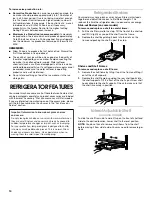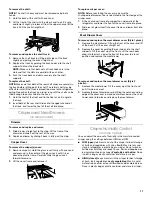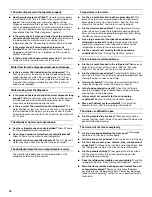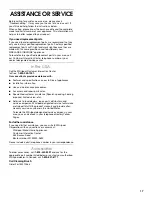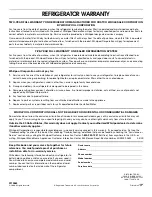
10
To increase ice production rate:
■
Normal Ice Production:
In normal ice production mode, the
ice maker should produce approximately 8 to 12 batches of
ice in a 24-hour period. If ice is not being made fast enough,
turn the Freezer Control toward a higher (colder) number in
half number steps. (For example, if the control is at 3, move it
to between 3 and 4.) Wait 24 hours and, if necessary,
gradually turn the Freezer Control to the highest setting,
waiting 24 hours between each increase.
■
Maximum Ice Production (on some models):
In maximum
ice production, the ice maker should produce approximately
16 to 20 batches of ice in a 24-hour period. If your refrigerator
has the maximum ice production feature, push the switch to
MAX.
REMEMBER:
■
Allow 24 hours to produce the first batch of ice. Discard the
first three batches of ice produced.
■
The quality of your ice will be only as good as the quality of
the water supplied to your ice maker. Avoid connecting the
ice maker to a softened water supply. Water softener
chemicals (such as salt) can damage parts of the ice maker
and lead to poor quality ice. If a softened water supply cannot
be avoided, make sure the water softener is operating
properly and is well maintained.
■
Do not store anything on top of the ice maker or in the ice
storage bin.
REFRIGERATOR FEATURES
Your model may have some or all of these features. Features that
can be purchased separately as product accessories are labeled
with the word “Accessory.” Not all accessories will fit all models.
If you are interested in purchasing one of the accessories, please
call the toll-free number on the cover or in the "Assistance or
Service" section.
Refrigerator Shelves
Your model may have glass or wire shelves. Store similar foods
together and adjust the shelves to fit different heights. This
reduces the time the refrigerator door is open and saves energy.
Slide-out Shelves (on some models)
To remove and replace a shelf in a metal frame:
1.
Pull the shelf forward to the stop. Tilt the front of the shelf up
and lift it slightly as you pull the shelf from the frame.
2.
Replace the shelf by guiding it back into the slots on the
frame and pushing the shelf in past the stop.
Shelves and Shelf Frames
To remove and replace a shelf/frame:
1.
Remove the shelf/frame by tilting it up at the front and lifting it
out of the shelf supports.
2.
Replace the shelf/frame by guiding the rear shelf hooks into
the shelf supports. Tilt the front of the shelf up until rear shelf
hooks drop into the shelf supports. Check to make sure that
the shelf is securely in position.
Lateral Adjustable Shelf
(on some models)
To slide the shelf from side to side, lift up on the front of shelf and
slide to the desired location. Lower shelf to the level position.
NOTE:
You do not have to remove small items from the shelf
before moving it from side to side. You may need to remove larger
items.
Important information to know about glass shelves
and covers:
Do not clean glass shelves or covers with warm water when
they are cold. Shelves and covers may break if exposed to
sudden temperature changes or impact, such as bumping.
For your protection, tempered glass is designed to shatter
into many small, pebble-size pieces. This is normal. Glass
shelves and covers are heavy. Use special care when re-
moving them to avoid impact from dropping.










